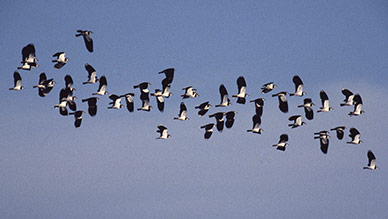Lapwing (Vanellus vanellus)
When: Mainly from February to July or August
How many: Relatively widespread and abundant breeder

Lapwing, green plover and peewit - all are fittingly descriptive, commonly used names for this attractive bird.
Lapwing! All who have witnessed at close quarters the lapwing’s frantically flapping display flights can testify to the noise made by the broad, sail-like wings. Then green plover. At a distance, lapwings appear black and white, but at close quarters, the beautiful metallic-green sheen is clearly visible. And peewit, of course, recalls the bird’s plaintiff cry when displaying or threatened.
It is perhaps surprising, though, that the crest has not featured in a country name. Longer in the male lapwing than in the female, and gracefully curved in both, it adds a touch of the exotic to what once was a common and widespread bird.
A small number of lapwings over-winter in the New Forest, but most typically arrive to breed in February or March. Lapwing nests, shallow scrapes lined with stems or leaves, are often sited on undisturbed areas of heathland and rough grassland. Short vegetation is preferred, and so are sites relatively close to grazed mire-edges where chicks can feed and shelter. Slight hillocks are favoured to enable sitting lapwings to command a reasonable view of their surroundings and obtain early views of potential predators.
Three to four well camouflaged, black-spotted, olive-brown eggs are laid, often as early as March.
Predation by crows is an ever-present danger, particularly when the adult lapwings are flushed from the nest by dogs, people or New Forest stock. Marauding foxes, too, probably take numerous lapwing clutches, but gone are the days when eggs were collected for sale to local hotels and restaurants.
Lapwing incubation lasts for around 28 days, and almost immediately after hatching, the down-covered youngsters are mobile, and able to find their way about unaided. They do, though, depend on their parents for around 38 days, when it’s not unusual to see them feeding on and around heavily grazed roadside verges.
There, the adult lapwings are incredibly conspicuous as cars speed by, but the youngsters, at first no more than tiny bundles of fluff, often go unnoticed.

By July, most lapwings leave the New Forest, and spend the autumn and winter in large flocks on agricultural land or on the coast. Harsh weather, though, will almost certainly stimulate further rapid movement to milder places to the south and west.
In the wider countryside, agricultural change and river valley drainage have led to substantial reductions in numbers of lapwings. But in the New Forest, recent research by the RSPB suggests an increase between 1994 and 2004 of 34-39% - from an estimated 85-86 lapwing pairs to 117 pairs. (It’s been suggested that this is at least partially attributable to the Forestry Commission’s heathland burning and cutting programmes that have increased the amount of habitat suitable for these birds).
References:
The Shell Guide to the Birds of Britain and Ireland: James Ferguson-Lees, Ian Willis and J.T.R. Sharrock
Hampshire Bird Reports: Hampshire Ornithological Society
The Birds of the Western Palearctic, Concise Edition: D.W. Snow and C.M. Perrins
New Forest Breeding Waders Survey 2004: A Survey of the Breeding Waders in the New Forest Valley Mires: R.D. Goater, C. Temple and A. Thomas
More links
Other related links
Search this site

Sadly, 58 animals were killed - 35 ponies, 13 cows, 8 donkeys and 2 sheep, whilst a further 32 were injured - 3 pigs, 9 donkeys, 11 cows and 9 ponies.
(Forty-three accidents occurred in daylight, 15 at twilight and 101 in the dark. Twenty-seven accidents were not reported by the driver involved).
Here's just one horrific example - Three donkeys killed in collision with van at notorious New Forest blackspot (Advertiser and Times)

